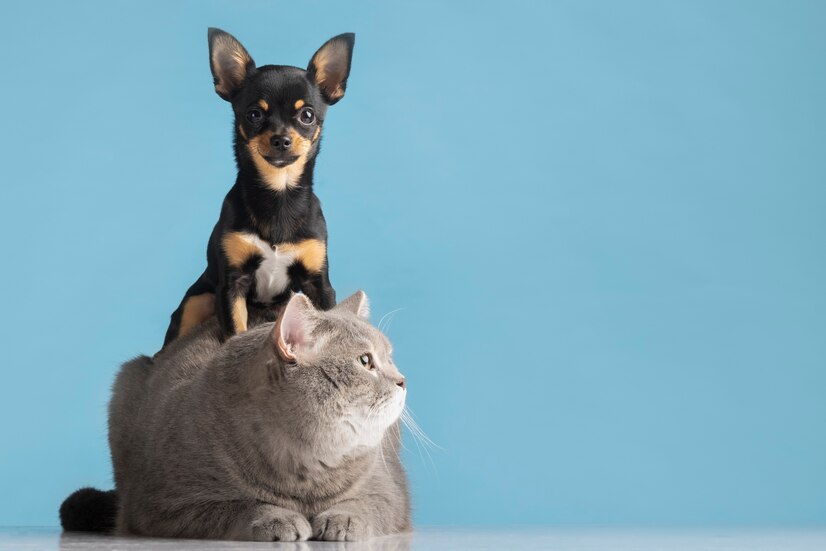Dogs and cats are two of the most beloved pets all around the world. Some people say they are natural enemies, while others believe they can be true friends and often play together. So, if you own both, you might find yourself wondering, “Can a dog get a cat pregnant?” or “Can cats and dogs mate with each other?”
Let me guess why someone might think this: perhaps both your dog and cat spend a lot of time together when you’re not home, and you notice your dog trying to mate with your cat. One thing I want to make clear is that dogs and cats are different species, and if you see your dog trying to mate with your cat, it might just be that he wants to play with her.
However, if your dog is doing this behavior continuously, you should be concerned—not because he can get your cat pregnant, but because your cat might start feeling annoyed, which could lead to behavioral changes, like a loss of appetite.
In this article, we will answer the question, “Can a dog get a cat pregnant?” and how you can stop your dog from humping your cat. Read on qoura
Can a Dog Get a Cat Pregnant?
No, a dog cannot make a cat pregnant due to differences in species, genetics, and biological factors. Species are groups of organisms that can interbreed and produce viable, fertile offspring. Cats and dogs belong to different species, and therefore, biological barriers prevent them from mating and producing offspring.
Genetic differences also play a role. Cats have 19 pairs of chromosomes (38 total), while dogs have 39 pairs of chromosomes (78 total). This significant difference in chromosome number makes it difficult for their genetic material to combine appropriately during fertilization.
The reproductive systems of cats and dogs are also different, making mating impossible. Their mating behaviors differ as well, which further prevents crossbreeding. Finally, there is no chance that your dog and your cat could get each other pregnant.
Can a Female Dog Get Pregnant by a Male Cat?
No, it is impossible. Dogs and cats are different species with unique reproductive systems and genetic makeups, which makes interbreeding impossible. Each species has specific reproductive barriers that prevent them from mating and producing offspring together.
Have There Ever Been a Dog and Cat Mix?
No, there has never been a dog and cat mix. Dogs and cats are different species, and their genetic differences make it impossible for them to interbreed.
Each species has its own unique reproductive system, which acts as a natural barrier, preventing them from mating and producing mixed offspring.
When Can Two Different Species Mate?
Two different species can usually mate if they are closely related and share a significant portion of their DNA. This often occurs within the same genus or family. However, even closely related species may have differences in their chromosomes or reproductive systems that prevent successful mating.
A classic example is the mule, which is a hybrid offspring of a donkey and a horse. While they can mate, the resulting offspring are usually sterile due to chromosomal differences.
Can Cats and Dogs Mate?
No, cats and dogs cannot mate with each other. They are different species with distinct genetics.
Cats can mate with:
- Wildcats
- Jungle cats
- Servals
- Asian leopard cats
- Ocelots
- Pampas cats
- Margays
- Northern tiger cat
- Andean mountain cats
Dogs can mate with:
- Wolves
- Coyotes
- Jackals
- Dingoes
Note: The resulting offspring may not be fertile or healthy. Sometimes genetic problems can arise.
What Causes a Dog to Mount a Cat?
Dogs may mount due to hormonal reasons, playful excitement, or even to show dominance. On the other hand, while this behavior can sometimes be sexual, it is often not directly related to mating and can occur in both neutered and non-neutered dogs.
Mounting is generally normal for dogs, but if it becomes excessive, it might indicate underlying health issues, such as skin allergies, urinary tract infections, or stress. If mounting becomes frequent or seems harmful, it’s a good idea to consult a veterinarian.
How do I stop my dog from humping my cat?
If your dog is humping your cat, it’s important to consider how often this happens and how much it bothers the cat. For many pets, this behavior isn’t a major concern. If the cat isn’t upset and both animals get along, you might not need to make any changes.
However, if the humping is causing issues, you can help your cat by providing raised surfaces, like cat trees or shelves, that the dog can’t reach. This gives the cat a safe space to retreat to. Read Also Can cats eat garlic?
Dogs may hump for various reasons, including playfulness or a natural sex drive. If the behavior is persistent, consider neutering your dog. If your female cat isn’t spayed, spaying her might reduce the behavior, especially if your dog reacts to her scent when she’s in heat.
Final Thoughts
A dog cannot impregnate a cat, as they are different species with incompatible DNA. If a dog mounts a cat, it’s likely due to playfulness or other non-mating reasons; consult a professional if the behavior persists.



